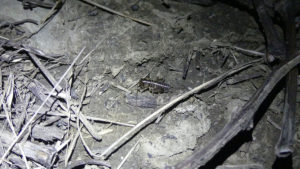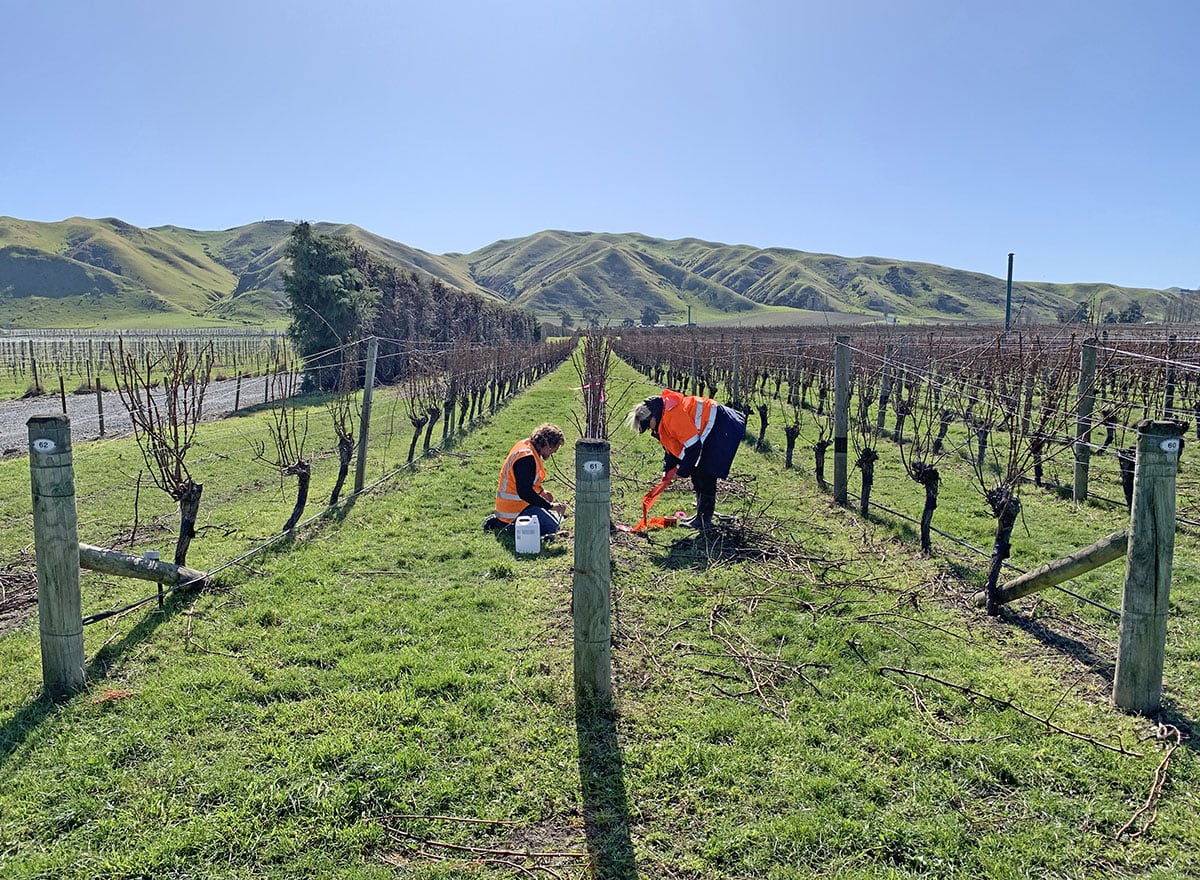Jessica Vereijssen, Mette Nielsen, Roger Wallis, Vaughn Bell, Richard Hunter, Stewart Graham (Plant & Food Research), Mary Morgan-Richards, and Steve Trewick (Massey University)
The endemic ground wētā, Hemiandrus bilobatus, lives in burrows in the soil, but its presence can negatively affect wine grape production. This is especially so in vineyards in the Awatere region in Marlborough. Vine growth in early spring provides the ground wētā with a buffet of fresh buds to feed upon, which causes damage detrimental to vine growth and fruit yield.
The current ground wētā management tool sees plastic sleeves wrapped around vine trunks in an attempt to prevent wētā from accessing the cordon. However, the sleeves are costly to install and maintain, resulting in a significant waste-management issue. This new project, which started on 1 July 2022, is funded by New Zealand Winegrower (NZW) levies and brings together scientists from Plant & Food Research (PFR) and Massey University. PFR scientist Dr Jessica Vereijssen leads the project, which includes Professors Mary Morgan- Richards and Steve Trewick, both of Massey University in Palmerston North. Their knowledge and experience of wētā will be invaluable in helping this study achieve the goals of seeking to understand the wētā–vine association and develop environmentally sustainable solutions where vineyards and the ground wētā can co-exist.

Ground wētā during an evening survey in the Awatere winegrowing region in September 2022
The wider project team includes grower representatives from local wineries to ensure that any proposed solutions are practical and financially sustainable. Since the first wētā article was reported in New Zealand Winegrower magazine in June/July 2022, good progress has been made. In early September 2022, PFR led a grower meeting at the Yealands Awatere Memorial Hall, which more than 20 growers and other interested parties attended. As well as describing the work to be done and potential solutions in future, PFR and growers identified 25 potential trial sites for wētā fieldwork.

Evening surveys for the ground wētā in the Awatere winegrowing region in September 2022
Also in September, PFR and Massey University researchers visited the Awatere region to begin fieldwork in time for budburst. Training in daytime identification of wētā burrows was undertaken, which is not straightforward because the wētā make soil plugs or doors to close their burrow entrances, so they are hidden from view. There are also other burrowing insects in the soil between the vines, such as Tasmanian pasture cockchafer and pasture wireworm, whose burrows need to be distinguished from the wētā burrows.
Researchers collected several wētā, and tikanga Māori protocols were adhered to. These wētā are now at Massey University and PFR Motueka, where rearing and assessments of diet are underway. In addition to the ground wētā, several other commonly found insects were collected from various study sites to gauge their potential contribution to bud damage on vines.
PFR researchers again visited the Awatere region in September, where they visited 16 study vineyards, of which nine were visited at night. These included Māori-owned, conventional, and organic vineyards. Ground wētā were observed at several sites, with further field assessments undertaken again in mid-October for the later budburst varieties. The team will return in January 2023 for surveys to aid in understanding ground wētā behaviour and diet outside the budburst period. The information from the two periods will be used to formulate sustainable solutions for the future.

Installing pitfall traps in a vineyard to catch walking/jumping insects
To round off this calendar year [2022], the PFR team are looking to speak with up to 20 growers, who will be asked about their vineyards and experiences of wētā, how it has influenced different areas of their vineyards, and what practices or tactics have been adopted (or might be in future) to counter wētā damage. These conversations will offer new insights into factors like wētā distribution, the extent of vine damage, and how it varies throughout the Awatere winegrowing region. Analysis of the conversations with growers, coupled with field observations during budburst and in January, will be used to find solutions for ground wētā and commercial vineyards to co-exist in the Awatere region. In 2023, a PhD student, guided and supported by the Massey professors, is expected to join the research project.
About the project
This three-year project is funded through the New Zealand Wine Futures Fund, which BRI launched in 2021 to bring new and novel ideas to levy-funded research. It is funded through NZW levies and project-managed by BRI. The wētā project has co-funding from Indevin, Pernod-Ricard, Yealands, and Hortus to support the Massey University PhD student. The science team is led by PFR, with significant in-kind contributions from Massey University.

















